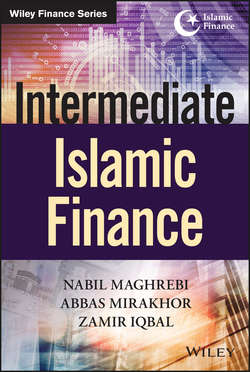Читать книгу Intermediate Islamic Finance - Mirakhor Abbas - Страница 7
На сайте Литреса книга снята с продажи.
Chapter 1
Epistemology of Finance
ОглавлениеWhether it be the question of philosophy of science, epistemology, ethics, philosophy of language or the relation between man and God, free will and determinism, causality or other philosophical questions with which various European and American philosophers have been struggling during the last few centuries, the vast intellectual tradition of Islam has provided answers of enduring validity.
– Seyyed Hossein Nasr (1993)
As with natural science, which refers to the branch of knowledge that concerns itself with the material world, finance is the discipline that deals with the properties of the financial system. The contents of Islamic finance may be better understood with respect to epistemological questions that arise also with respect to conventional finance: what is known, how this knowledge is acquired, and what determines its accumulation in this discipline. This chapter argues that there are fundamental differences in the sources of knowledge, and that there are some common epistemological threads between conventional finance and Islamic finance. It is essential to consider the notion of rationality in the behavior of economic agents, but it is also important to understand the full complexion of finance in relation to morality and justice. It is indeed the concepts of “general rules of morality,” a “sense of justice,” “natural justice,” and “natural equity” that underlie Adam Smith's theses about competitive economy. Additionally, Islamic finance derives its moral and ethical standards from the teachings of Islam, which provide a code of conduct for the behavior of financial markets and institutions. The conventional financial system is derived from the economic system, which is the product of the socio-political-economic system. The ideal conventional system can be traced back to the treatises of Adam Smith, which go beyond the ideas contained in The Wealth of Nations (which is widely regarded as marking the beginning of modern economics). These epistemological roots can be traced back to his earlier work, The Theory of Moral Sentiments. The Arrow-Debreu model of general equilibrium that embodies Adam Smith's vision of a competitive economy also provides a theoretical framework for risk sharing. The ideal Islamic finance system also proposes a set of risk-sharing instruments that cover the full spectrum of risk–return profiles, which facilitate the optimal risk allocation function of the financial sector within an Islamic economy. This economy is characterized by an institutional structure that is derived, epistemologically, from Islamic teachings as operationalized by the Noble Messenger (saws) and includes also a code of behavior for market participants. This institutional framework ensures, among other things, property rights protection, good governance, and contract enforcement. Islamic finance allows for an optimal allocation of risk through risk-sharing mechanisms, where the rewards on financial transactions are derived from the real economy and where risk and return cannot be divorced.
It can be thus argued that there are three central threads running through the ideal Islamic finance and ideal conventional finance: (1) consistency with human nature, (2) existence of a moral and justice system essential to long-term social and economic sustainability, and (3) optimal allocation of resources based on the risk-sharing mechanism. The rethinking of financial architecture following the onset of financial crises, as well as the emergence or re-emergence of Islamic finance may be better understood against their epistemological backgrounds. It can be argued that the inception of the Islamic finance industry over the past few decades has been in response to a “market failure” to meet the demand for Sharīa'h-compliant ways of financing. The development of Islamic finance reflects, in part, the need expressed over the years by Muslim scholars not only for the elimination of interest-based contracts, but also for their substitution with risk-sharing instruments. The Kuala Lumpur Declaration of October 2012 by participants at the Second Strategic Roundtable Discussion, including prominent scholars in Sharīa'h and Islamic economics, indeed considers risk sharing as the essence of Islamic finance. The resurgence of Islamic finance was rather the result of efforts by practitioners to develop financing instruments with the dual purpose of meeting Sharīa'h requirements and remaining familiar to market players in the conventional finance. Whereas Islamic finance emphasizes the completeness of contracts, in the sense that parties to the contract should share expected profits as well as potential losses, conventional finance is more oriented toward risk transfer and risk-shifting transactions. It can thus be argued that conventional finance provided the platform for the emergence of Islamic finance, and it is the incompleteness of markets and contracts for risk allocation that may in part explain this development.
This chapter addresses the main issues related to the epistemology of finance, drawing in part from earlier work by Mirakhor (2011), Mirakhor and Smolo (2011), and Mirakhor and Bao (2013). It includes also new perspectives about the rethinking of conventional economics, the institutional structure, the essence of risk sharing, and the role of government in the promotion of risk sharing. This chapter examines, first, the epistemology of an ideal conventional financial system based on the body of knowledge derived from the seminal work by Smith and Arrow. The inherent risks of the conventional financial system in its present architecture, and attempts to converge toward an ideal structure, are also explored. The ideal Islamic financial system is considered in the second part of the chapter. The discussion centers on the institutional structure, which emphasizes the role of contracts of exchange, trust, and markets. The argument is then made that at the foundation of this ideal system lies the risk-sharing mechanism, which allows for an optimal allocation of risk in the society depending on idiosyncratic levels of risk tolerance. Finally, the chapter considers the essential role of equity and stock markets as the ideal instrument and platform for risk sharing and long-term financing of real investment.
